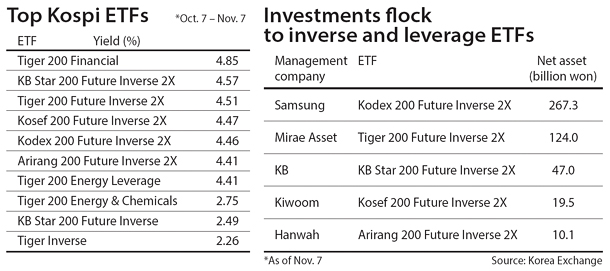Investors turn to inverse ETFs

However, not all investors are gloomy as some have profited from the lackluster stock market by investing in inverse exchange-traded funds, or ETFs.
Inverse ETFs are commonly used by investors to hedge their portfolio against falling prices as they are designed to perform as the inverse of whatever index or benchmark it is designed to track, or whenever the market, falls.
Among the top 10 ETFs traded on the benchmark Kospi by yield between Oct. 7 and Nov. 7, most were inverse ETFs, according to the Korea Exchange.
Interest has been growing as the five inverse ETFs that were launched in September by Samsung, Mirae Asset, KB, Kiwoom and Hanwha attracted 467.9 billion won ($412 million).
The KB Start 200 Future Inverse 2X yield ranked second highest by yield with 4.57 percent followed by third-place Mirae Asset’s Tiger 200 Future Inverse 2X with a yield of 4.51 percent.
Other inverse ETFs are posting similar yields between 2 and 4 percent.
Their performance is exceptional considering that the 91 ETF products on the market have been suffering an average yield of minus-2.19 percent.
Samsung’s Kodex 200 Future 2X had the best performance by transaction as 121.5 billion won worth have been sold and bought since Oct. 7. Mirae Asset’s Tiger 200 Future Inverse 2X has also been enjoying active transactions of 99.6 billion won during the same period. This is equivalent to 20 percent of the total Kospi ETF transactions during the same period last year at 739.9 billion won.
The popularity of inverse ETF grew as the Kospi fell below 2,000 largely due to the mood caused by the scandal in the Blue House. The Kospi, which was long been stuck in the 2,000 range, gradually retreated and finally fell on Nov. 2 after losing more than 28 points, a drop of 1.42 percent.
On Tuesday, the market bounced back to 2,000 for the first time in four trading days.
While foreign and institutional investors can hedge their investments by short-selling when the mood of the market is unfavorable, the only available tool that retail investors can rely on is inverse ETFs.
“Most of the investors that are purchasing inverse 2X ETFs are retail investors,” said Lee Joong-ho, an analyst at Yuanta Securities Korea. “These [retail investors] are buying inverse ETFs even when the [Kospi] index rises because they believe it will fall as they see the market being burdened [by the rise].”
The current sentiment weighing on the market is that the recent trend will unlikely be resolved soon as there are other major issues that could hold back the Kospi from moving up, including the political deadlock regarding the future of President Park Geun-hye, the U.S. presidential election and the U.S. Federal Reserve’s decision to raise the key interest rate next month.
Market experts warn investors that inverse ETFs should be considered a short-term investment strategy rather than a long-term plan, especially since their losses will double when the market bounces up.
“For a safe investment, it is best to diversify ETF investments, including those investing overseas [rather than focusing too much on inverse ETFs],” Lee said.
BY SHIM SAE-ROM, LEE HO-JEONG [lee.hojeong@joongang.co.kr]










with the Korea JoongAng Daily
To write comments, please log in to one of the accounts.
Standards Board Policy (0/250자)